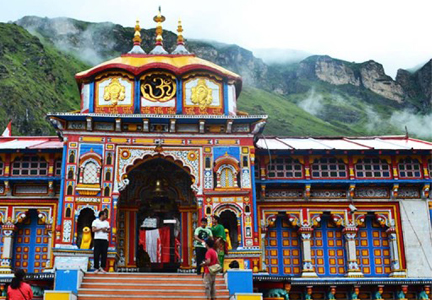Badrinath – The Legend and History of the Temple

“If you want to progress on the path of yoga, this is needed. Not knowing where the end is, simply keep going. ‘It doesn’t matter where it begins or where it ends, till I reach there, I simply keep going.’ Unless a person has this attitude and strength within himself, the spiritual path is out of question.”
—Sadhguru
Sadhguru looks at the legend of Badrinath temple and how Vishnu tricked Shiva and Parvati, and its history of how Adi Shankaracharya established the temple over a thousand years ago.
Sadhguru: There is a legend about Badrinath. This is where Shiva and Parvati lived. It is a magnificent place at around 10,000 feet in the Himalayas. One day, Shiva and Parvati took a walk. When they came back, at the entrance of their home a little baby was crying. Looking at this child crying his heart out, Parvati’s maternal instincts came up and she wanted to go pick up the child. Shiva stopped her and said, “Don’t touch that child.” Parvati replied, “How cruel. How can you say that?”
Shiva said, “This is not a good baby. Why does he land up at our doorstep by himself? There is no one around, no footprints of parents in the snow. This is not a child.” But Parvati said, “Nothing doing! The mother in me will not allow me to let the child be like this,” and she took the baby into the house. The child was very comfortable, sitting on her lap, looking very gleefully at Shiva. Shiva knew the consequence of this but he said, “Okay, let’s see what happens.”
Parvati comforted and fed the child, left him at home and went with Shiva for a bath in the nearby hot water springs. When they came back, they found the doors were locked from the inside. Parvati was aghast. “Who has closed the door?” Shiva said, “I told you, don’t pick up this child. You brought the child into the house and now he has locked the door.”
Parvati said, “What shall we do?”
Shiva had two options: one was to burn up everything in front of him. Another was to just find another way and go. So he said, “Let’s go somewhere else. Because it’s your beloved baby, I cannot touch it.”
Shiva had two options: one was to burn up everything in front of him. Another was to just find another way and go. So he said, “Let’s go somewhere else. Because it’s your beloved baby, I cannot touch it.”This is how Shiva lost his own home and Shiva and Parvati became “illegal aliens”! They walked around, looking for an ideal place to live and finally settled down in Kedarnath. Did he not know, you may ask. You know many things, but you still allow them to happen.
Adi Shankaracharya and Badrinath
Badrinath also has historical significance because the temple here was installed by Adi Shankara. Adi Shankara was born in a place called Kaladi in Kerala over a thousand years ago. He was a prodigal child and an extraordinary scholar with almost super-human capabilities. At the age of two, he could fluently speak and write Sanskrit. At the age of four, he could recite all the Vedas, and at the age of twelve, he took sanyas and left his home. Even at such a young age, he gathered disciples and started walking throughout the country to re-establish the spiritual sciences.
Adi Shankara’s guidance came from Gowdapada. Under his guidance, Shankara went about doing all this incredible work. Gowdapada is very much a part of our tradition also. He was an extraordinary guru, but his teachings were never written down. He made sure it was not written down. He must have taught thousands of people but he produced fifteen to twenty good people who re-established the spiritual science in the country very quietly, without any noise, without starting a new religion or anything. In many ways, that has been the intention of Isha’s work also – not to establish a new religion or a new scripture, but to establish the spiritual sciences just as a way of life, as an inculcation within a human being.
The Badrinath temple was installed by Adi Shankara. He set up his own people there. Even today, the descendants of the families that he set up traditionally, the Nambudiris, are the priests in the temple. Visually, this area is an incredible place. The town is not very well kept, but if you look around at the rest of it, it is incredibly beautiful. From Govind Ghat to Badri, that 25-kilometer drive is probably the most incredible drive you can have anywhere in the world. I have traveled to many places but this 25-kilometer drive is so incredible, there are no words to describe how the mountains are.
From Kaladi to Badrinath, the distance is more than three thousand kilometres by walk. Adi Shankara walked such distances not just south to north but also east to west. He walked up and down the country thrice and east to west once. Once, when he was up in the north, he came to know intuitively that his mother was dying. At the age of twelve, his mother had given him permission to take sanyas only after he had promised her that he would be there with her at the moment of her death. So when he realized that his mother was ill, he walked all the way back to Kerala just to be with her beside her deathbed. He spent a few days with his mother and after she had died, he walked back north again. When you travel to the Himalayas, you will wonder how anyone could have walked through this. Imagine the effort involved. Motorized travel destroyed pilgrimage! If you had walked, it would settle your life for good.
The purpose of coming to the Himalayas is not to achieve something. This was an opportunity to simply be dwarfed – if not dissolved, at least to be dwarfed. You can’t believe that thousands of years of ago, people went into these mountains when there were no roads, automobiles or maps of where the mountain begins and where it ends. Just going. If you want to progress on the path of yoga, this is needed. Not knowing where the end is, simply keep going. “It doesn’t matter where it begins or where it ends, till I reach there, I simply keep going.” Unless a person has this attitude and strength within himself, the spiritual path is out of question.
Editor’s Note: Isha’s Sacred Walks to the Himalayas will be taking place in September 15 – 25 this year. Registrations are now open. Register Now!


